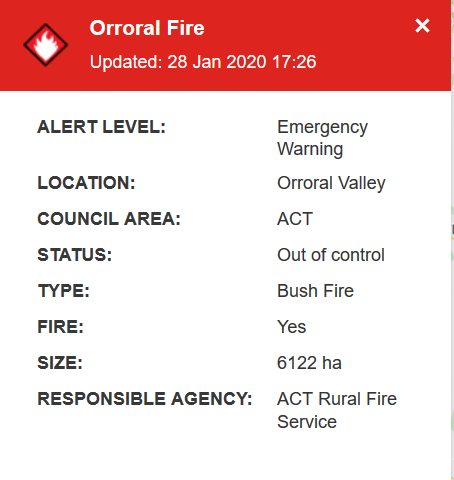Pyrocumulonimbus clouds from the Out of control Bush Fire at the Orroral Valley Namadgi National Park ACT.
Tuesday 28 January 2020 out of control bush fire created The cumulonimbus flammagenitus cloud (CbFg), also known as the pyrocumulonimbus clouds, that were visible from 60 kilometers away.
Watch this video.
Canberra Times reported the following on Tuesday 28.01.2020.
“People in Tharwa ACT are being told it is now too late to leave as an emergency level out-of-control bushfire burning in the Namadgi National Park approaches.
At 4.30pm, the ACT Emergency Services Agency said people in Tharwa, Boboyan Road, Apollo Road and Top Naas Road should seek shelter immediately. This was reiterated at 5pm.
As of 3.15pm, fire was climbing towards the crest of Mt Tennent and expected to begin throwing forward spot fires to areas around Namadgi Visitor Information Centre soon.
An air tanker was dropping fire retardant around the top of Mt Tennent just before 4pm.
“Helicopters and Large Air Tankers are water-bombing, establishing containment lines and undertaking aerial surveillance,” the ESA said at 5.30pm.

The fire did not pose an immediate threat to southern suburbs in Tuggeranong as of 5.30pm, but ESA commissioner Georgeina Whelan said the fire was spotting and the distance to town areas would reduce in coming hours.
People in Banks, Conder, Gordon, Smiths Road, the remote area of Orroral Valley should activate their bushfire plans or identify where they would go if they need to leave.
People in Calwell and Theodore are advised to monitor the situation and stay up to date.
Tharwa resident of 42 years Kevin Hogan was staying back late on Tuesday afternoon to defend his property from possible ember attack as the Orroral Valley fire approached.”
Pyrocumulonimbus cloud
“The cumulonimbus flammagenitus cloud (CbFg), also known as the pyrocumulonimbus cloud, is a type of cumulonimbus cloud that forms above a source of heat, such as a wildfire or volcanic eruption, and may sometimes even extinguish the fire that formed it.
It is the most extreme manifestation of a flammagenitus cloud. According to the American Meteorological Society’s Glossary of Meteorology, a flammagenitus is “a cumulus cloud formed by a rising thermal from a fire, or enhanced by buoyant plume emissions from an industrial combustion process.”
Analogous to the meteorological distinction between cumulus and cumulonimbus, the CbFg is a fire-aided or –caused convective cloud, like a flammagenitus, but with considerable vertical development. The CbFg reaches the upper troposphere or even lower stratosphere and may involve precipitation (although usually light), hail, lightning, extreme low-level winds, and in some cases even tornadoes.
The combined effects of these phenomena can cause greatly increased fire-spread and cause direct dangers on the ground in addition to ‘normal’ fires.
The CbFg was first recorded in related to fire following the discovery in 1998 hat extreme manifestations of this pyroconvection caused direct injection of large abundances of smoke from a firestorm into the lower stratosphere. The aerosol of smoke comprising CbFg clouds can persist for weeks, and with that, reduce ground level sunlight in the same manner as the “nuclear winter” effect.”
Source: https://en.wikipedia.org/wiki/Cumulon…
